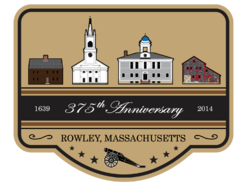Rowley (town), Massachusetts
| Rowley, Massachusetts | ||
|---|---|---|
| Town | ||

Rowley, Massachusetts celebrated its 375th anniversary in 2014
|
||
|
||
 Location in Essex County and the state of Massachusetts. |
||
| Coordinates: 42°43′00″N 70°52′45″W / 42.71667°N 70.87917°WCoordinates: 42°43′00″N 70°52′45″W / 42.71667°N 70.87917°W | ||
| Country | United States | |
| State | Massachusetts | |
| County | Essex | |
| Settled | 1638 | |
| Incorporated | 1639 | |
| Government | ||
| • Type | Open town meeting | |
| Area | ||
| • Total | 20.3 sq mi (52.7 km2) | |
| • Land | 18.2 sq mi (47.2 km2) | |
| • Water | 2.2 sq mi (5.6 km2) | |
| Elevation | 50 ft (15 m) | |
| Population (2013) | ||
| • Total | 5,973 | |
| • Density | 290/sq mi (110/km2) | |
| Time zone | Eastern (UTC-5) | |
| • Summer (DST) | Eastern (UTC-4) | |
| ZIP code | 01969 | |
| Area code(s) | 351 / 978 | |
| FIPS code | 25-58405 | |
| GNIS feature ID | 0618309 | |
| Website | www |
|
Rowley is a town in Essex County, Massachusetts, United States. The population was 5,856 at the 2010 census.
Part of the town comprises the census-designated place of Rowley.
In spring of 1639 Rowley was originally settled as a plantation by Reverend Ezekiel Rogers, who had arrived from England on the ship John of London with approximately twenty families. The John of London also brought over the first printing press in the colonies, which was later brought to Harvard University.
The following spring, on September 4, 1639, the town was incorporated, and included portions of modern-day Byfield, Groveland, Georgetown, and Haverhill. The town was named after Rowley, East Riding of Yorkshire, where Rogers had served as pastor for twenty years before his suspension due to non-conformist Puritan beliefs. Rogers was installed as Rowley's pastor on December 3.
1643 and 1645 saw the construction of a fulling mill and grist mill, respectively. The town became known for its hemp and flax cloth, as well as cotton. In 1642, a keystone arch bridge and a dam were built on the Mill River for the fulling mill, the first such in the colonies. The bridge was the first stone arch bridge in North America, constructed entirely of hand-chiseled granite and contained no mortar. It was rebuilt in the mid-19th century. In 1669, a sawmill was established in town and is still in business today. A wagon factory was built in 1868 by Moses E. Daniels. Later, at the start of the 20th century, the town had a booming shoe industry, as well as successful boat building businesses.
...
Wikipedia

